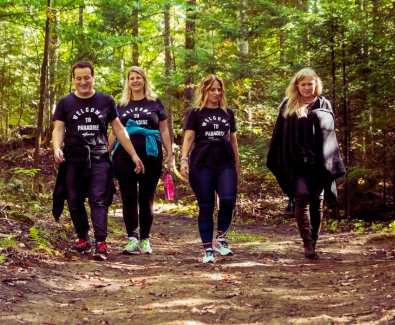The Algonquin Story
Grail Springs acknowledges Canada’s ‘Truth and Reconciliation Commission’ goals, and in the expression of reconciliation, we open and close all of our special events with ceremony that acknowledges the First Nation Algonquin People since our participation in 2010.
Grail Springs Retreat Centre for Wellbeing is located in the Shawashkong Basin. By visiting Bancroft's Eagles Nest Park with its lookout point (approx a 10-min drive from Grail Springs) you can view the valley and the York River which established its present form about 4,700 years ago. This area was inhabited by the Algonquin people as far back as 11,500 years and said to have been the most populated area in all of Canada.
Beginning in the mid-19th century settlers began coming into North Hastings from Ireland, England, Scotland, France, Germany, Poland and Scandinavia. The newly expanding lumber industry sought immigrants seeking a better life, and offered work harvesting the majestic white pine for British naval ships. The development of the first colonization roads such as Hastings, Monck and Snow Road running through Bancroft, encouraged families along with free land grants, to settle in this area. Grail Springs is bordered on the north end of the property by the old Hastings passageway, travel impressions you can still see in the ground if you know where to look. In 1994 an old clapboard house was torn down across the lake from Grail Springs which it is said to have been a 19th-century trading post and inn for settlers on route to the north.
The Algonquins are masters of canoe making and canoe travel. They used an extensive system of portage routes to move between various encampment areas throughout their territory. Travels were based on the seasonal needs of acquiring the available resources for survival. They would choose resource-rich areas close to beaches with a southern exposure for prolonged warmth and daylight.
In the summer of 1993 the great, great, great granddaughter of the original immigrant settler of this land had visited Grail Springs and shared, when they were children and played on the beach they had found many ancient artifacts such as tools and arrowheads. Evidence of these seasonal encampments exist at numerous archaeological sites along York and Madawaska River.
By the end of the nineteenth century, ‘Algonquin’ had become regularized to refer the Mohawks (to the east), the Atikamekw and Cree (to the northeast and the north), and the Anishinaabe (to the west and the south).
.png)
Today members of the Algonquin community help keep their culture, language and spiritual traditions alive by demonstrating the art of birch bark canoe building, conducting discovery tours, drumming circles and ceremonies at special events, and by actively participating in projects such as ‘Eagles Nest – An Algonquin Story’, a spectacular lookout point where one can view the Shawashkong Basin.
Plan ahead and visit some of these First Nation sites:
Eagles Nest Park lookout point (7 kms north)
Algonquin Provincial Park (50 kms north) Peace & Reconciliation Totem Pole
Petroglyph Provincial Park - ‘The Teaching Rocks’ Algonkian 1000 AD – Open May to October (80 kms south)
You can also visit the 'Peace and Reconciliation Totem Pole' in Algonquin Park which was erected in October 2015.



.png)

